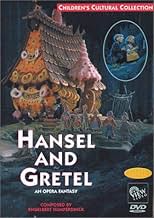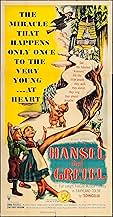Aggiungi una trama nella tua linguaAn "electronic puppet" version of the Humperdinck opera, adapted for children and using spoken dialogue as well as Humperdinck's music.An "electronic puppet" version of the Humperdinck opera, adapted for children and using spoken dialogue as well as Humperdinck's music.An "electronic puppet" version of the Humperdinck opera, adapted for children and using spoken dialogue as well as Humperdinck's music.
- Regia
- Sceneggiatura
- Star
- Premi
- 1 vittoria e 1 candidatura in totale
Mildred Dunnock
- Mother
- (voce)
Frank Rogier
- Father
- (voce)
Delbert Anderson
- Sandman
- (voce)
Helen Boatwright
- Dew Fairy
- (voce)
- (as Helen Boatright)
Constance Brigham
- Hansel
- (voce)
- …
Recensioni in evidenza
Despite its European, "old world" look, Hansel and Gretel was made in New York City. Indeed the comments to the contrary are a tribute to the filmmakers' success in evoking a genuine fairy tale style. Nonetheless, the film was shot using conventional stop-motion puppets (notwithstanding the producer's claims to using some sort of mysterious "electronic" method) in the main room of an abandoned courthouse which is still standing at the corner of Second Avenue and Second Street in New York City. The large set was built in the main chamber on the second floor (now the largest of several theaters in what is currently (2005) the Anthology Film Archives).
Apparently electromagnets were used to hold the stop-motion puppets in place during some sequences, but normal procedures were used for the rest. This and some hype that lured in backers may account for the mistaken report that they are electronic puppets. They were solid, armature puppets and not clay (or "claymation") dolls.
The set survived the production and actually toured county fairs as a fairy tale exhibit for many years after the completion of the film.
Apparently electromagnets were used to hold the stop-motion puppets in place during some sequences, but normal procedures were used for the rest. This and some hype that lured in backers may account for the mistaken report that they are electronic puppets. They were solid, armature puppets and not clay (or "claymation") dolls.
The set survived the production and actually toured county fairs as a fairy tale exhibit for many years after the completion of the film.
Saw this a year ago.
It's a nice little musical, I like the songs and the old timey stop motion is pleasant. But dear lord, that mom needs child protective services called on her.
Also, the original version I saw it in was English, but I watched the Danish dub recently and apparently the witch is voiced by a guy? Interesting... wonder if that's the case for other dubs.
It's a nice little musical, I like the songs and the old timey stop motion is pleasant. But dear lord, that mom needs child protective services called on her.
Also, the original version I saw it in was English, but I watched the Danish dub recently and apparently the witch is voiced by a guy? Interesting... wonder if that's the case for other dubs.
This was the first full-length stop-motion feature made in the United States. In spite of other comments posted here Mybergh's "Hansel and Gretel" was filmed entirely in New York City.
The film was done sequentially and as funding for the production dried up and the release date drew nearer the animators were forced to speed things up. The animation becomes quite hurried and sloppy near the end and if you look closely you will notice that both the angels from the Dream Pantomime and the Revived Gingerbread Children are only multiple castings of both Hansel and Gretel redressed. There simply was no time to do original sculptures for these characters.
This was to be the first in a series of full-length stop motion features by Mybergh's production team, but despite it doing exceptional business in Germany it failed to ignite at the box office in the United States. According to members of the Mybergh Estate most of the original elements are still intact and we can only hope that someone will take it upon themselves to do a proper restoration of this amazing film to replace the shoddy, amateur DVD edition that is currently available. Anna Russell's vocal performance as Rosina Rubylips is one that is unlikely to ever be equaled and Evalds Dajevskis' set designs definitive.
The film was done sequentially and as funding for the production dried up and the release date drew nearer the animators were forced to speed things up. The animation becomes quite hurried and sloppy near the end and if you look closely you will notice that both the angels from the Dream Pantomime and the Revived Gingerbread Children are only multiple castings of both Hansel and Gretel redressed. There simply was no time to do original sculptures for these characters.
This was to be the first in a series of full-length stop motion features by Mybergh's production team, but despite it doing exceptional business in Germany it failed to ignite at the box office in the United States. According to members of the Mybergh Estate most of the original elements are still intact and we can only hope that someone will take it upon themselves to do a proper restoration of this amazing film to replace the shoddy, amateur DVD edition that is currently available. Anna Russell's vocal performance as Rosina Rubylips is one that is unlikely to ever be equaled and Evalds Dajevskis' set designs definitive.
This film has always been one of my top favorite childhood films. "Hansel and Gretel" was not always easily accessible to kids. Although it had sporadic television showings back in the days of black and white televisions, kids normally had to wait about every three years for it to be theatrically re-released to see it. I remember seeing it once on television back in the days before we had color television sets and then seeing it several years later on the big screen (in all of its Technicolor splendor) and it captivated me by being the definitive version of the famous tale. I liked it so much that when they re-released it some years later I went to see it again! After the mid-seventies it more or less disappeared and it seemed to have become a forgotten film (shown occasionally on early cable T.V.). However, in the early eighties I was surprised to see it on VHS through a company called Media Home Entertainment. Sadly, their print had a terrible mono soundtrack making the film inaudible and the scene where the the stars form in the heavens (after the Sandman floated away) looked like it was set in the daytime instead of at night-time. Later, in the eighties a no-frills video company released the same print with a marginally better soundtrack. When HBO showed it in the early nineties, they showed a restored quality print. One with perfect sound and with the stars in the heavens forming in the evening (keeping to the evening setting of Hansel and Gretel asleep under a tree in the forest). Not long afterward, that restored version was put on to VHS by Vestron and I was delighted. Too bad that Vestron didn't hold on to the rights long enough to put out a DVD edition of the film. It has since fallen into the hands of another company and they've evidently used a not exactly perfect VHS print of the film as the master source for their DVD presentation of "Hansel and Gretel". The evidence of VHS decay are sporadically obvious during the film. It's annoying that the company probably had the means to give us "the" perfectly restored version of the film on DVD, but instead decided to gyp us with a low-budget video to DVD transfer of it. I hope that another company will obtain the rights to this film and put a good copy of it on the market soon. "Hansel and Gretel" must have been a pretty big hit in its day (1954). There was a comic book and a record album of this film. I know that the two times that I saw it in the theaters it played to packed movie houses. Let's hope to see a restored DVD edition of it the near future!
This is a stop-motion animation film of the Hansel and Gretel fairy tale, done, apparently, somewhere in Europe--the Austrian Apollo Boys Choir does the background vocals, so the film could have been made there or in nearby Hungary or Czechoslovakia, both of which were producing well-done animation films--but passed off as an American film, which it is not. Considering the time it was made and the conditions existing in Europe during that period, it is an admirable attempt indeed. The stop-motion, while not up to the standards of Ray Harryhausen, who was doing similar work at the time, is still well-done, and great care was obviously taken in the dubbing and scoring of the film. The background music is at times a bit overpowering, and there are spots where the dialogue is drowned out by it, but there are some imaginative touches throughout and and some visually beautiful moments. Children who are used to today's high-tech computer animation may not be impressed technically, but the film overall should appeal to them. Recommended.
Lo sapevi?
- QuizRe-released in 1972 as part of MGM's Children's Matinees package.
- ConnessioniFeatured in Animation Lookback: The Best of Stop Motion - The First Features (2014)
I più visti
Accedi per valutare e creare un elenco di titoli salvati per ottenere consigli personalizzati
Dettagli
- Data di uscita
- Paese di origine
- Lingua
- Celebre anche come
- Hansel and Gretel: An Opera Fantasy
- Luoghi delle riprese
- New York, New York, Stati Uniti(Studio)
- Azienda produttrice
- Vedi altri crediti dell’azienda su IMDbPro
- Tempo di esecuzione1 ora 12 minuti
- Mix di suoni
Contribuisci a questa pagina
Suggerisci una modifica o aggiungi i contenuti mancanti

Divario superiore
By what name was Hansel and Gretel (1954) officially released in Canada in English?
Rispondi



















